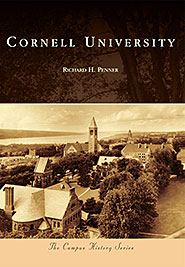New book traces why Cornell is a 'world treasure'

A new book shows just how unique Cornell University is among educational institutions.
Founded in 1865 soon after the Civil War, the university was a grand experiment in nonsectarianism and coeducation. It is the only Ivy League university that is also its state's land-grant school. And if that's not enough to set it apart, consider its breadth: In addition to traditional majors in the liberal arts, engineering, business, agriculture and architecture, Cornell has colleges of hotel management, human ecology, labor relations, veterinary medicine and medicine. It has campuses in Geneva, N.Y., New York City and Doha, Qatar -- plus the new Cornell Tech campus rising on Roosevelt Island adjacent to Manhattan.
The new book, "Cornell University" (Arcadia Publishing), by Richard H. Penner, B.Arch. '69, M.Arch. '72, Cornell professor emeritus of hotel administration, traces the university's history in 128 pages with 200 vintage black-and-white photographs, mostly from the Cornell University Library archives.
Starting with the university's founding, the book not only chronicles the institution's history, but goes on to highlight notable students including E.B. White, Margaret Bourke-White, Ken Dryden and Ruth Bader Ginsburg; student life including skating, ice hockey, a toboggan slide on Beebe Lake, traying on Libe Slope, the "mud" rush, Dragon Day and Slope Day; athletics including the women's rifle team and the "crew train"; such notable faculty as Vladimir Nabokov, Hans Bethe and Carl Sagan; and the campus today.
In a recent reaccreditation report, the university "was referred to by the professors on the visiting team as a 'world treasure,'" Penner begins his book. From its inception, Penner writes, the university was a pace setter for its wide-ranging curriculum and diverse student body that included women, minority and international students.
Penner taught design and development to Hotel School students for more than 40 years at Cornell. He has been deeply involved with the design and operation of campus facilities, serving as chairman of university committees on campus planning, parking and transportation, residence life and student unions.
The book is part of the publisher's Campus History Series.
Media Contact
Get Cornell news delivered right to your inbox.
Subscribe